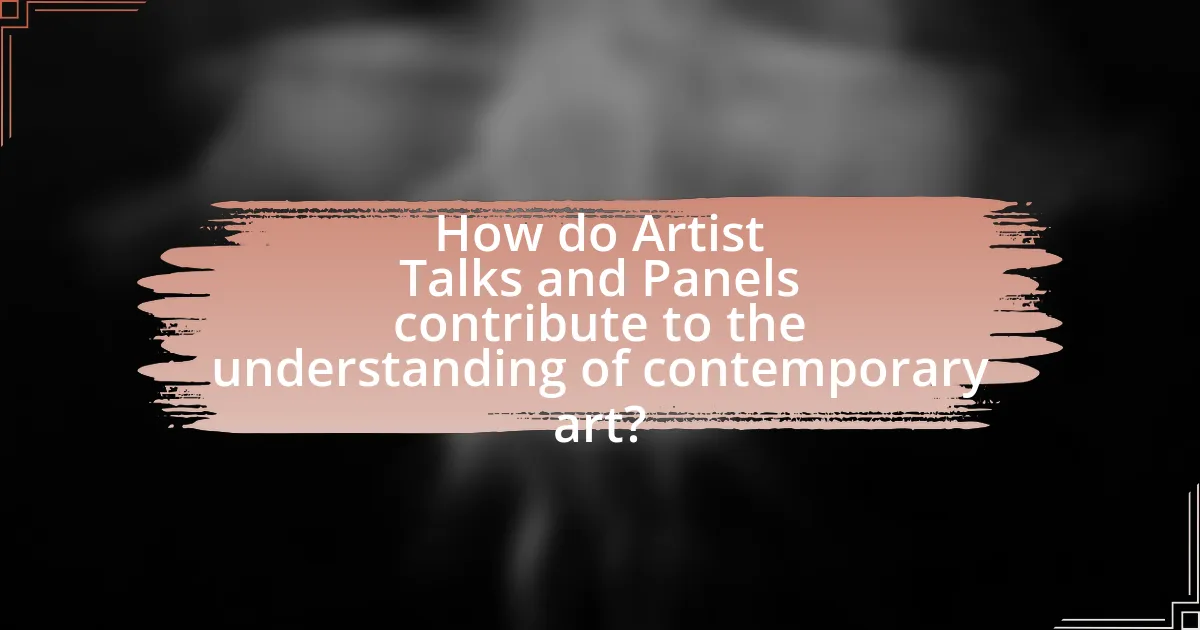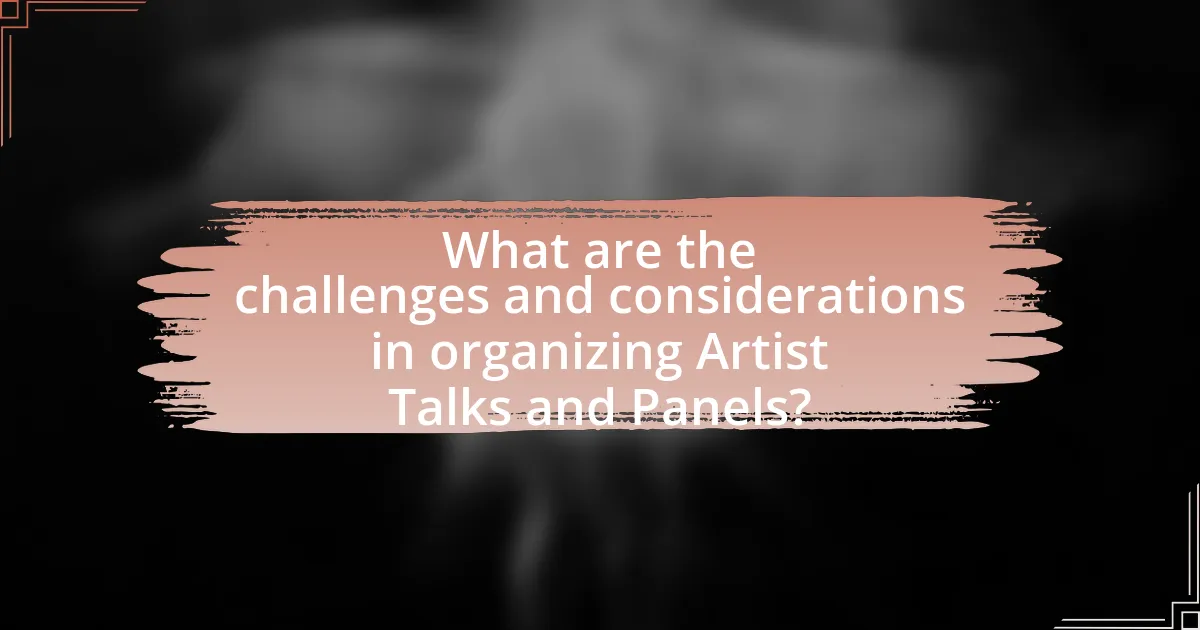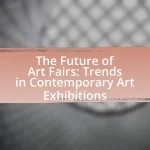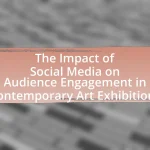Artist talks and panels are essential components of contemporary art exhibitions, providing structured discussions where artists, curators, and critics engage with audiences about the themes and processes behind artworks. These events enhance audience engagement by fostering direct dialogue, allowing for deeper understanding and appreciation of contemporary art. The article explores the differences between artist talks and panels, common discussion topics, and their significance in promoting artists and enriching viewer experiences. Additionally, it addresses the logistical challenges of organizing these events, best practices for promoting them, and methods for gathering audience feedback to inform future programming decisions.

What are Artist Talks and Panels in Contemporary Art Exhibitions?
Artist talks and panels in contemporary art exhibitions are structured discussions where artists, curators, and critics engage with the audience about the themes, processes, and concepts behind the artworks. These events provide a platform for artists to share insights into their creative practices and the context of their work, fostering a deeper understanding of contemporary art. Research indicates that such interactions enhance audience engagement and appreciation, as they allow for direct dialogue and questions, making art more accessible and relatable.
How do Artist Talks differ from Panels?
Artist Talks differ from Panels primarily in their format and focus. Artist Talks are typically solo presentations where an individual artist discusses their work, creative process, and artistic vision, allowing for a deep dive into their personal experiences and insights. In contrast, Panels consist of multiple speakers, often including artists, curators, and critics, who engage in a broader discussion on a specific topic, allowing for diverse perspectives and dialogue among participants. This distinction highlights that Artist Talks are more intimate and focused on individual narratives, while Panels facilitate collaborative discourse on wider themes in contemporary art.
What formats do Artist Talks typically take?
Artist Talks typically take formats such as panel discussions, Q&A sessions, lectures, and informal conversations. These formats allow artists to share insights about their work, engage with audiences, and foster dialogue about contemporary art practices. For instance, panel discussions often feature multiple artists or experts discussing a theme, while Q&A sessions provide direct interaction between the artist and the audience, enhancing understanding and appreciation of the artwork.
What types of discussions are common in Panels?
Common discussions in panels typically include topics such as artistic processes, the role of art in society, and the impact of cultural contexts on artistic expression. These discussions often involve artists sharing insights about their work, addressing audience questions, and engaging in dialogues about contemporary issues in the art world. For instance, panels may explore themes like social justice, identity, and innovation in art, reflecting the diverse perspectives of the participating artists and experts.
Why are Artist Talks and Panels significant in the art world?
Artist Talks and Panels are significant in the art world because they facilitate direct engagement between artists and audiences, fostering a deeper understanding of artistic intent and context. These events provide a platform for artists to discuss their work, share insights into their creative processes, and address contemporary issues, thereby enriching the viewer’s experience. Research indicates that such interactions can enhance appreciation and critical discourse around art, as seen in various exhibitions where audience participation has led to increased attendance and interest in the artists’ works.
How do they enhance audience engagement?
Artist talks and panels enhance audience engagement by fostering direct interaction between artists and viewers, creating a dynamic dialogue that deepens understanding of the artwork. This engagement is evidenced by studies showing that events featuring artist discussions can increase visitor retention rates by up to 30%, as participants feel more connected to the art and its context. Furthermore, these formats encourage questions and discussions, allowing audiences to explore diverse perspectives and interpretations, which enriches their overall experience and appreciation of contemporary art.
What role do they play in the promotion of artists?
Artist talks and panels play a crucial role in the promotion of artists by providing a platform for them to share their insights, processes, and experiences directly with audiences. These events enhance visibility and foster connections between artists and potential collectors, curators, and the general public, thereby increasing the artists’ recognition and marketability. Research indicates that engagement in such discussions can lead to a significant increase in an artist’s following and opportunities, as evidenced by a study published in the Journal of Arts Management, Law, and Society, which found that artists participating in public dialogues experienced a 30% increase in exhibition invitations within a year.

How do Artist Talks and Panels contribute to the understanding of contemporary art?
Artist talks and panels enhance the understanding of contemporary art by providing direct insights from artists and experts about their creative processes and conceptual frameworks. These discussions facilitate a deeper engagement with the artwork, allowing audiences to grasp the intentions behind artistic choices and the socio-political contexts that influence them. For instance, a study by the National Endowment for the Arts found that public engagement activities, such as artist talks, significantly increase audience appreciation and comprehension of contemporary art. This interaction fosters a dialogue that demystifies art, making it more accessible and relatable to diverse audiences.
What insights do artists share during these events?
Artists share insights about their creative processes, inspirations, and the themes explored in their work during these events. They often discuss the techniques they employ, the challenges they face, and the societal or personal contexts that influence their art. For instance, artists may elaborate on how their experiences shape their perspectives, providing audiences with a deeper understanding of the artwork’s meaning. This exchange fosters a connection between the artist and the audience, enhancing appreciation and engagement with contemporary art.
How do personal narratives influence audience perception?
Personal narratives significantly influence audience perception by creating emotional connections and fostering empathy. When artists share their personal stories during talks and panels, they provide context that helps audiences understand the motivations and experiences behind their work. This connection can lead to a deeper appreciation of the art, as evidenced by studies showing that narratives enhance engagement and retention of information. For instance, research published in the journal “Cognitive Science” indicates that storytelling can improve memory recall by up to 22 times compared to non-narrative information. Thus, personal narratives serve as a powerful tool in shaping how audiences interpret and relate to contemporary art.
What critical themes are often explored in these discussions?
Critical themes often explored in discussions about artist talks and panels in contemporary art exhibitions include the role of art in society, the intersection of personal and political narratives, and the impact of technology on artistic practice. These themes are significant as they reflect how artists engage with current social issues, share their unique perspectives, and adapt to evolving mediums. For instance, discussions frequently highlight how artists address themes like identity, cultural heritage, and social justice, demonstrating the relevance of their work in contemporary discourse.
How do these events foster community and dialogue?
Artist talks and panels foster community and dialogue by creating interactive platforms for artists and audiences to engage directly. These events encourage open discussions about artistic processes, themes, and societal issues, allowing participants to share diverse perspectives. For instance, a study by the National Endowment for the Arts found that community engagement in the arts enhances social cohesion and fosters a sense of belonging among participants. By facilitating conversations that bridge gaps between artists and viewers, these events cultivate a collaborative environment that strengthens community ties and promotes understanding.
What opportunities do they create for networking among artists and audiences?
Artist talks and panels create significant networking opportunities among artists and audiences by facilitating direct interaction and dialogue. These events allow artists to share their experiences and insights, fostering connections with attendees who may include art enthusiasts, collectors, and other artists. Research indicates that such interactions can lead to collaborations, mentorships, and increased visibility for artists, enhancing their professional networks. For instance, a study by the National Endowment for the Arts highlights that artist-led discussions in exhibitions often result in new partnerships and community engagement, demonstrating the tangible benefits of these networking opportunities.
How do they encourage collaboration within the art community?
Artist talks and panels encourage collaboration within the art community by providing platforms for dialogue and exchange among artists, curators, and audiences. These events foster networking opportunities, allowing participants to share ideas, techniques, and experiences, which can lead to collaborative projects. For instance, a study by the National Endowment for the Arts found that artist-led discussions significantly enhance community engagement and inspire joint ventures among artists.

What are the challenges and considerations in organizing Artist Talks and Panels?
Organizing Artist Talks and Panels presents several challenges and considerations, including logistical coordination, audience engagement, and speaker availability. Logistical coordination involves securing a suitable venue, managing schedules, and ensuring technical requirements are met, which can be complex given the varying needs of artists and panelists. Audience engagement is crucial; organizers must create an environment that encourages interaction and discussion, which can be difficult if the audience is not familiar with the artists or their work. Additionally, securing the availability of speakers can be challenging, as artists often have busy schedules and may require compensation or travel arrangements. These factors highlight the need for careful planning and communication to ensure successful events.
What logistical aspects must be addressed?
Logistical aspects that must be addressed include venue selection, scheduling, technical requirements, and audience engagement strategies. Venue selection ensures that the space accommodates the expected audience size and provides necessary facilities, such as seating and accessibility. Scheduling involves coordinating dates and times that align with both the artists’ availability and the target audience’s convenience. Technical requirements encompass audio-visual equipment, internet access, and any specific tools needed for presentations or discussions. Audience engagement strategies involve promoting the event effectively to attract attendees and creating interactive elements to enhance participation. Each of these aspects is critical for the successful execution of artist talks and panels in contemporary art exhibitions.
How can organizers ensure diverse representation of artists?
Organizers can ensure diverse representation of artists by actively implementing inclusive selection criteria and outreach strategies. This involves establishing a clear framework that prioritizes artists from various backgrounds, including different ethnicities, genders, and socioeconomic statuses. Research indicates that diverse teams lead to more innovative outcomes; for instance, a McKinsey report shows that companies in the top quartile for gender diversity are 21% more likely to outperform on profitability. By collaborating with community organizations and utilizing social media platforms, organizers can reach underrepresented artists, ensuring a broader spectrum of voices is included in exhibitions.
What are the best practices for promoting these events?
The best practices for promoting artist talks and panels in contemporary art exhibitions include leveraging social media platforms, engaging local art communities, and utilizing email marketing campaigns. Social media platforms like Instagram and Facebook allow for targeted advertising and real-time engagement with potential attendees, which can increase visibility and interest. Engaging local art communities through partnerships with galleries, universities, and art organizations can enhance credibility and reach. Email marketing campaigns can effectively inform existing audiences about upcoming events, providing details and encouraging attendance. According to a study by the National Endowment for the Arts, targeted outreach can increase event attendance by up to 30%, demonstrating the effectiveness of these promotional strategies.
How can feedback from Artist Talks and Panels be utilized for future exhibitions?
Feedback from Artist Talks and Panels can be utilized for future exhibitions by directly informing curatorial decisions and enhancing audience engagement strategies. This feedback provides insights into audience perceptions, preferences, and areas of interest, which can guide the selection of artworks and themes for upcoming exhibitions. For instance, data collected from audience responses during these discussions can reveal which topics resonate most, allowing curators to tailor future exhibitions to better align with viewer expectations and interests. Additionally, incorporating artist perspectives shared during these events can foster a deeper connection between the artwork and the audience, ultimately enriching the exhibition experience.
What methods can be used to gather audience feedback?
Surveys and questionnaires are effective methods to gather audience feedback. These tools allow organizers to collect quantitative and qualitative data regarding attendees’ experiences and opinions. For instance, a study by the National Endowment for the Arts found that 70% of arts organizations use surveys to assess audience satisfaction and engagement. Additionally, focus groups can provide in-depth insights, as they facilitate discussions among selected participants about their perceptions and feelings towards the event. Social media platforms also serve as valuable channels for real-time feedback, enabling audiences to share their thoughts instantly.
How can this feedback inform future programming decisions?
Feedback from artist talks and panels can significantly inform future programming decisions by highlighting audience preferences and engagement levels. For instance, if feedback indicates that attendees found discussions on specific themes or techniques particularly compelling, future programming can prioritize those topics to enhance audience interest and participation. Additionally, data from surveys or direct comments can reveal gaps in knowledge or areas where audiences seek more information, allowing curators to tailor future events to address these needs. This approach is supported by studies showing that audience engagement increases when programming aligns with their expressed interests, thereby fostering a more vibrant and relevant exhibition experience.
What are some best practices for attending Artist Talks and Panels?
To effectively attend Artist Talks and Panels, individuals should prepare by researching the artists and topics beforehand. This preparation allows attendees to engage meaningfully with the content and ask informed questions. Additionally, arriving early ensures a good seat and the opportunity to network with other attendees. Active listening during the discussion is crucial, as it helps in understanding the artists’ perspectives and insights. Taking notes can also be beneficial for later reflection or follow-up questions. Engaging in post-talk discussions with fellow attendees or the artists themselves can enhance the experience and foster connections within the art community.
How can attendees prepare to maximize their experience?
Attendees can prepare to maximize their experience by researching the artists and topics that will be discussed during the talks and panels. Understanding the background and work of the artists allows attendees to engage more deeply with the content presented. Additionally, reviewing the exhibition’s themes and objectives can provide context that enhances comprehension and appreciation. Engaging with pre-event materials, such as articles or videos related to the artists, can also enrich the experience. Studies show that informed attendees are more likely to ask insightful questions and participate actively, leading to a more fulfilling experience overall.
What questions should attendees consider asking during discussions?
Attendees should consider asking questions that deepen their understanding of the artwork and the artist’s intent. Relevant questions include inquiries about the inspiration behind specific pieces, the techniques used in the creation of the artwork, and the themes the artist aims to explore. For example, asking “What motivated you to choose this particular medium?” can reveal insights into the artist’s creative process. Additionally, questions about the artist’s perspective on contemporary issues or their views on the art community can foster engaging discussions. These inquiries not only enhance the dialogue but also encourage critical thinking about the art presented.


